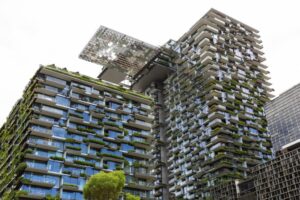ULI Special Report: The Past, Present, Future of CBDs

Top-of-mind for both panelists and attendees on the third day of the Urban Land Institute’s spring meeting were questions surrounding the changing nature of central business districts, especially in the face of high office vacancy rates and region-specific acute development hurdles.
Within a discussion called Fostering Next Generation Central Business Districts, two domestic markets, New York City and Miami, were compared with Seoul and Hong Kong, two cities that have adapted to similar and acute challenges through close collaboration with the government, alongside making their central business districts desirable as opposed to necessary.
A tale of two cities
Where contrasts were concerned, the pandemic’s effects on office vacancy rates between New York City and Seoul, which has an inventory of comparable size to Manhattan, could not be more glaring. While the Big Apple now sits at a roughly 20 percent office vacancy rate, Seoul’s is at 1.5 percent. According to Jun Ho Pok, CEO of IGIS Neovalue Asset Management, the city’s “quick return to normalcy” owed in part to experience containing an outbreak of Middle East respiratory syndrome back in 2015, allowed it to avert both a lockdown and its permanent effects on office work. Pok attributes these successes to a mix of mass testing, tech-enabled contact tracing and “government transparency,” that many other cities of comparable size lacked at the time.
In contrast, for New York City, the pandemic’s tolls on human life and the effects of lockdowns and hybrid work completely reshaped how the millions working around Lower Manhattan up through Midtown not only use their office spaces but interact with the area’s larger economy as a whole. Where future uses are concerned, “(it) cannot look like a bunch of large, tall commercial offices that are only occupied Tuesday through Thursday, with many of them, alongside their surrounding restaurants, shops and bodegas vacant Friday through Monday,” according to Megumi Brod, senior managing director of Rockefeller Group.
READ ALSO: Infrastructure Upgrades Are Critical for CRE’s Future
To Brod, Manhattan needs to become a “24/7 live-work-play type environment,” thought of as something beyond rows of office towers and tourist attractions. Still, given the city’s regulatory challenges, a lack of physical space and actual demand, never mind construction costs and interest rates, this is easier said than done.
For Brod, the solution lies in “working with the government and incentivizing appropriately,” by focusing more on affordable to build, live in and occupy mixed-use developments rather than pure Class A office space or luxury rentals and condos. The latter may make the most sense from a pure profitability standpoint, but they damage the city’s living and work experiences in the long-term, particularly as the middle class gets priced out of more and more neighborhoods. “Developers will see some of the incentives,” Brod said. “Lenders and all sorts of capital providers will also see that if appropriately done,” Brod added.
But Brod was still realistic about what this process could physically involve, beyond tax abatement programs. Offices with smaller floorplates need to be converted, while “some buildings will suffer and be demolished,” Brod said. “They can’t service their debt, and they may need to sell at low or depressed prices, which could lead to someone demolishing the building for different uses altogether,” Brod added.
The cities learn from each other
In contrast to New York City, Miami’s office market appears to be performing far better, with only a 10 percent vacancy rate. Kevin Davenport, a senior vice president at Swire Properties, sees the market as “cyclical,” with the current zenith brought on by an influx of people and companies that begun in April of 2020. “The Class A spaces are all fully leased, while their utilization is very high,” Davenport said.
Speaking with firsthand experience regarding his firm’s development of Brickell City Centre, Davenport explained that much of the success and demand of Miami’s CBD is its inclusion of office space in a more seamless manner with retail and multifamily in a way that resembles Hong Kong, where the firm is based. “If you look at the composition of their CBD areas, the uses of the office component are 20 to 30 percent of the overall space, depending on how you devise the downtown area,” Davenport detailed.
Miami is similar, in that “it’s a landscape of different uses, and environments where you (already) have the retail and amenities in place,” something that lies in contrast to Manhattan’s rigidity.
But it’s not all sunshine in the Sunshine State. A need for transportation, both public and private, cannot keep up with commuter demand and a growing population. Traffic remains as congested as ever, while Metromover and Metrorail remain “underutilized,” according to Davenport. “Transportation is one of the key barriers to true sustainable growth,” Davenport reflected. And even the city’s Class A office spaces themselves are not always something that a prospective tenant from New York City and Chicago would even want; “they’re single-tenant buildings that are self-financed, or a smaller building with an institutional partner,” Davenport noted.
In addressing both these problems, Davenport believes that these cities should take inspiration from their Asian counterparts. One area where this is demonstrated in real time is LEED and Well certification, something that began in Swire’s Asia portfolio. “We brought a lot of those key learnings over to Miami,” Davenport concluded.
The post ULI Special Report: The Past, Present, Future of CBDs appeared first on Commercial Property Executive.




